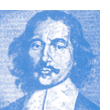URL: https://www.desy.de/school/school_lab/zeuthen_site/vacuum_lab/vacuum_information/history/otto_von_guericke/index_eng.html
Breadcrumb Navigation

|
|
Otto von Guericke
(*1602 in Magdeburg, †1686 in Hamburg)Without prior knowledge of the experiments by Torricelli
and Pascal, the engineer and future mayor of Magdeburg
Otto von Guericke began reflecting on the subject of the
vacuum. Stimulated by the laws of Kepler on the movement
of the planets, he represented the notion that the empty
space was to be the most natural reception in nature. If not
so, the planets would long have been lost their energy of
motion to the medium surrounding them and thus fallen
from the sky.
His first attempts to produce vacuum with a modified fire
engine, a plunger pump for fire water, failed miserably. The
container filled with water, first wooden barrels and later on
made of metal, were permeable or they imploded upon
evacuation. Following this, he left the trail of water and used
air filled hollow spheres and an air pumps with ongoing
success. Therewith, he was able to produce a vacuum and
further more invented the air pump (an original is shown at
the German Museum in Munich).
Otto von Guericke realised “An abhorrence of the empty room
can not be witnessed in nature, it can be substituted with the
pressure of the surrounding air."
Beside a sequence of experiments developed by von Guericke,
he conducted the most famous demonstration concerning
vacuum. Two rows of eight horses were not able to separate
two copper hemispheres of approx. 50 cm diameter, sealed
with a leather strip soaked with wax and turpentine oil. A child
on the other hand, was easily able to loose the connection of
the two “Magdeburg hemispheres “ by twisting a valve.
|




